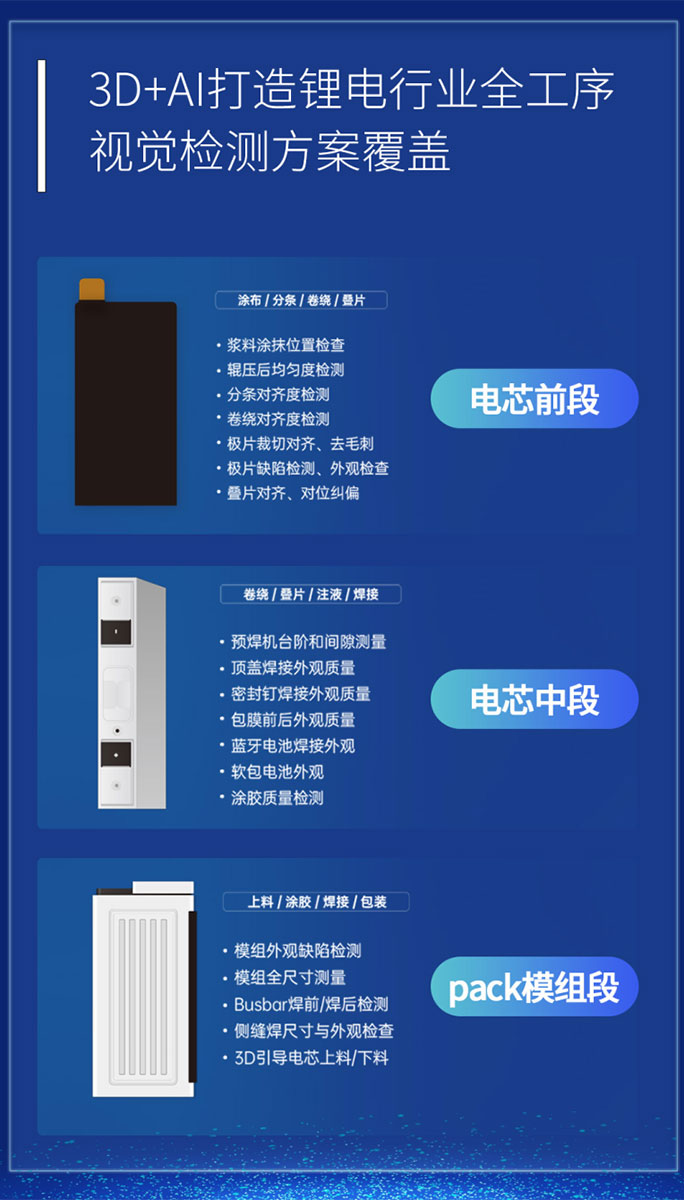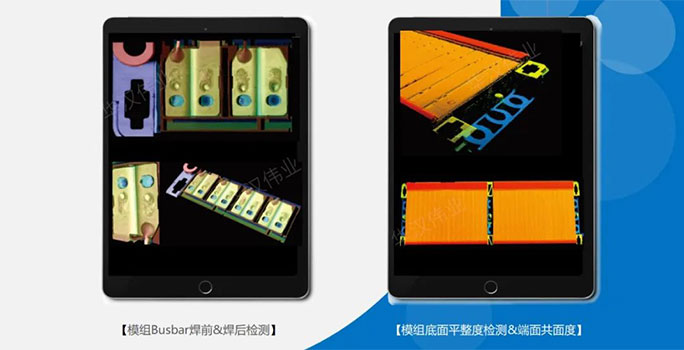

With the proposal of the "dual carbon" goal and the continuous expansion of application fields such as new energy vehicles and energy storage, power batteries, as the upstream industry and core components of new energy vehicles, are benefiting from the release of policy dividends in the production and sales of new energy vehicles and are experiencing rapid development.
In order to meet the rapidly growing market demand, battery production enterprises continuously break through in manufacturing processes and technologies, seize the market by manufacturing more efficient products, and continuously open new production lines and factories to meet the demand for production capacity.
In the era of large-scale manufacturing of lithium-ion batteries, ensuring that quality inspection can catch up with production and ensuring the production quality of products is a prerequisite for the good development of power batteries. As a result, machine vision inspection has been widely used in multiple stages of power battery production due to its advantages such as efficiency and intelligence, providing protection for battery quality control.
The production of lithium batteries is a complex system with a long production process, involving more than 50 processes, including: positive electrode, negative electrode, separator, electrolyte, current collector and binder, conductive agent, etc. The reactions involved include electrochemical reactions between positive and negative electrodes, lithium ion conduction and electron conduction, as well as heat diffusion.
With the accumulation of technical experience and the increasing demand from downstream major customers, lithium battery production is shifting from manufacturing to intelligent manufacturing, posing new requirements for the interactive correction ability, accuracy, speed, and stability consistency of equipment. The pursuit of energy conservation and emission reduction in the production process, as well as the ultimate pursuit of production efficiency, are also simultaneously reshaping the entire industry.
The defects such as bubbles, black spots, and scratches generated during the production process of lithium batteries, as well as the misalignment of pole ears, can affect battery quality and even cause explosions. This requires real-time visual inspection of the lithium battery production process to ensure consistency and stability of the production line.
Starting from the CATL era, battery manufacturers have increasingly attached importance to machine vision inspection, while also requiring visual inspection solution suppliers to have a deep industry accumulation and technical accumulation in the entire process of power batteries. They can have a deep understanding of inspection problems, achieve rapid response to customer needs, and implement deep level solutions.
In machine vision inspection projects, battery manufacturers have two main demands:
(1) Let quality inspection catch up with production and shorten the time for the landing of new lithium battery production capacity;
(2) Visual inspection should be able to deal with various complex defects, and the detection yield should be close to 100%.
To address the pain points in the lithium battery industry and bring more value to customers, how to shorten the preparation time of production lines and achieve the rapid landing of new power battery production lines; How to improve the yield of testing and meet the efficiency goals of enterprises has become an important topic for Huahan Weiye to consider.
Faced with the testing needs of various new production lines in the lithium battery industry, Huahan Weiye relies on its self-developed deep learning algorithm to quickly understand and evaluate defects in multiple core sections of power batteries based on process information. Combined with the industry Know How formed by the landing and application of lithium battery industry projects, the full process testing needs of the lithium battery industry are precipitated into a normalized visual inspection solution.

Front section of battery cell
In the front-end process of battery cells, Huahan Weiye provides standardized solutions for surface defect detection, size detection, coating appearance defect detection, slitting and winding defect detection, and pole ear appearance defect detection.
Based on a deep understanding of the materials and processes involved in battery production, during the preparation of lithium battery production equipment, Huahan Weiye synchronously outputs customized testing solutions, which greatly shortens the preparation time of the production line and ensures a high defect detection rate. This enables the rapid landing of new power battery production lines, allowing quality inspection to catch up with production and empowering intelligent manufacturing with machine vision.

Mid section of battery cell
For some key processes in the middle section of the battery cell, such as quality inspection of battery top cover welding, defect detection of sealing nail welding path, and defect detection after blue film of battery pack, Huahan Weiye relies on its self-developed advantages of deep learning algorithms at the bottom layer to apply the traditional 2D/2.5D/3D imaging technology+AI deep learning fusion machine vision detection technology to the entire middle process of the battery cell.
Through the characteristics of small sample learning and multi image flow image coordination processing in AI visual inspection, irregular object defects are identified. For various common defect types such as scratches, damages, dents, indentations, creases, etc., the deep fusion of 3D+AI synchronously achieves accurate defect identification and detection, with higher accuracy. The deep integration of deep learning and industry applications further improves the yield and efficiency of the entire production line.

pAck module segment
As an important component of the three electric systems (battery, motor, and electronic control) of new energy vehicles, the quality of lithium batteries directly affects the product performance and industry reputation of the vehicle.

To this end, Huahan Weiye has developed a comprehensive inspection plan for power modules. For example, comprehensive solutions such as module full-size measurement, Busbar post weld inspection, and module 3D positioning and grabbing have been implemented for multiple battery module projects, all of which have been delivered 100% within the specified time. Whether it is detection accuracy, size visual detection accuracy, or CT time, they have all reached the leading level in the industry and received widespread praise from customers.
In multiple production scenarios in the lithium battery industry (battery cells, modules, PACK packages), the implementation of HANSWELL machine vision and deep learning detection technology provides assurance for the quality of power batteries. With its accumulated application experience, the company has achieved full coverage of defect detection projects throughout the entire process of the lithium battery industry.
At the same time, Huahan Weiye has also accumulated rich industry experience in the three electric systems of new energy vehicles, possessing profound technical research capabilities, and shaping a high-quality brand of machine vision with high-quality services and good reputation.
In the future, HANSWELL will also closely follow industry trends, actively explore the new energy industry market with the spirit of innovation and service, and iterate and upgrade together with the entire automotive industry.